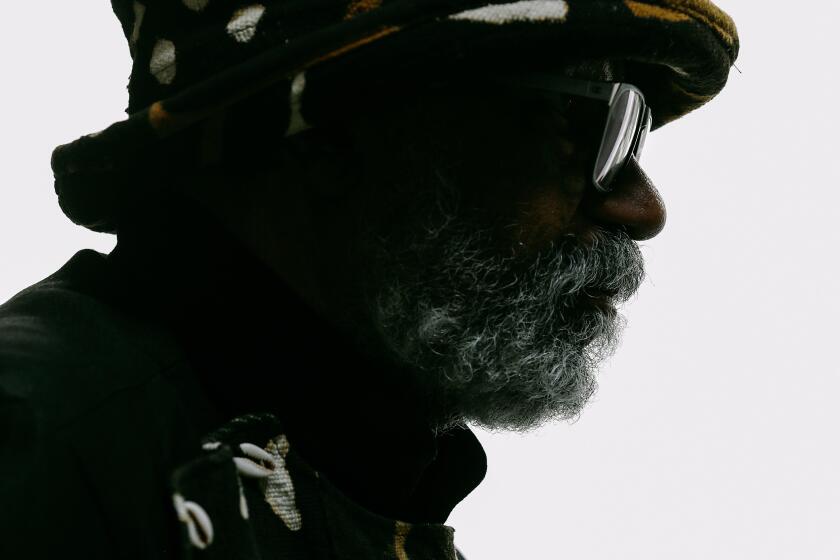Review: Spanish conquistadors and plastic vomit: That’s ‘Lifes’ at UCLA Hammer Museum
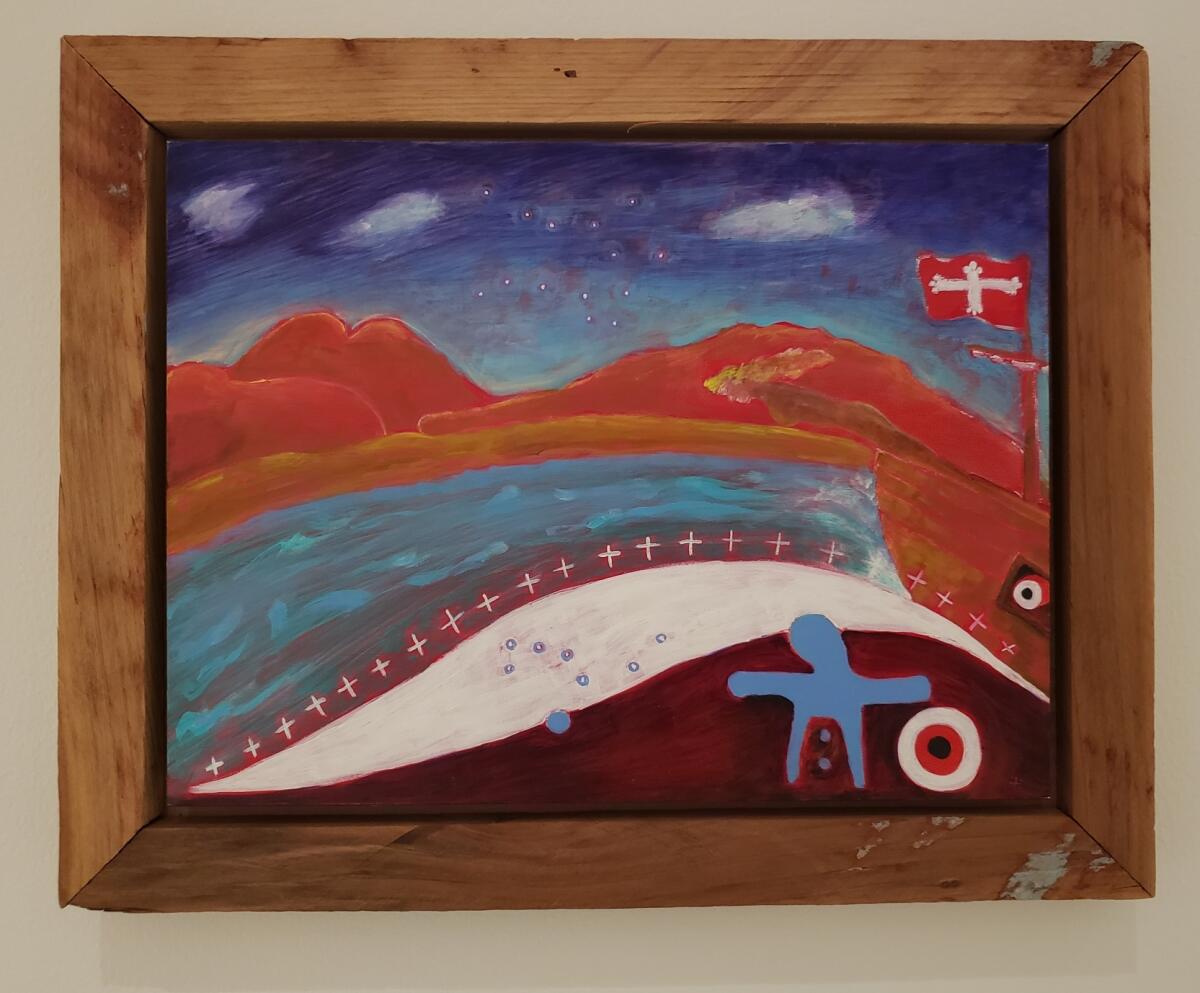
Midway through my recent visit to see “Lifes,” an eccentric exhibition in one large gallery at the UCLA Hammer Museum, a clattering sound accompanied by a visual blur rocketed through the room.
A long, fat, clear plastic tube, suspended on wires from the ceiling, emerged from a wall, dipped and disappeared into another wall, burst out of another wall, then disappeared back into a wall again. Each architectural encounter between tube and wall was framed by a large decal — a wall-papered digital image of a white gallery torn open, its constructed innards of bricks and mortar exposed, as if the wall had been smashed with a sledgehammer.
What was the passing blur? To find out, locating the wall label was necessary.
The plastic conduit is a pneumatic tube, a device for transporting an object from here to there using compressed air. A small capsule gets pushed along inside the cylinder. A sort of industrial carrier pigeon, popular long before email and Amazon, pneumatic tubes used to be common in office buildings, hospitals, department stores and such. You could send a memo, a medical directive or an invoice from one floor to another in no time flat.
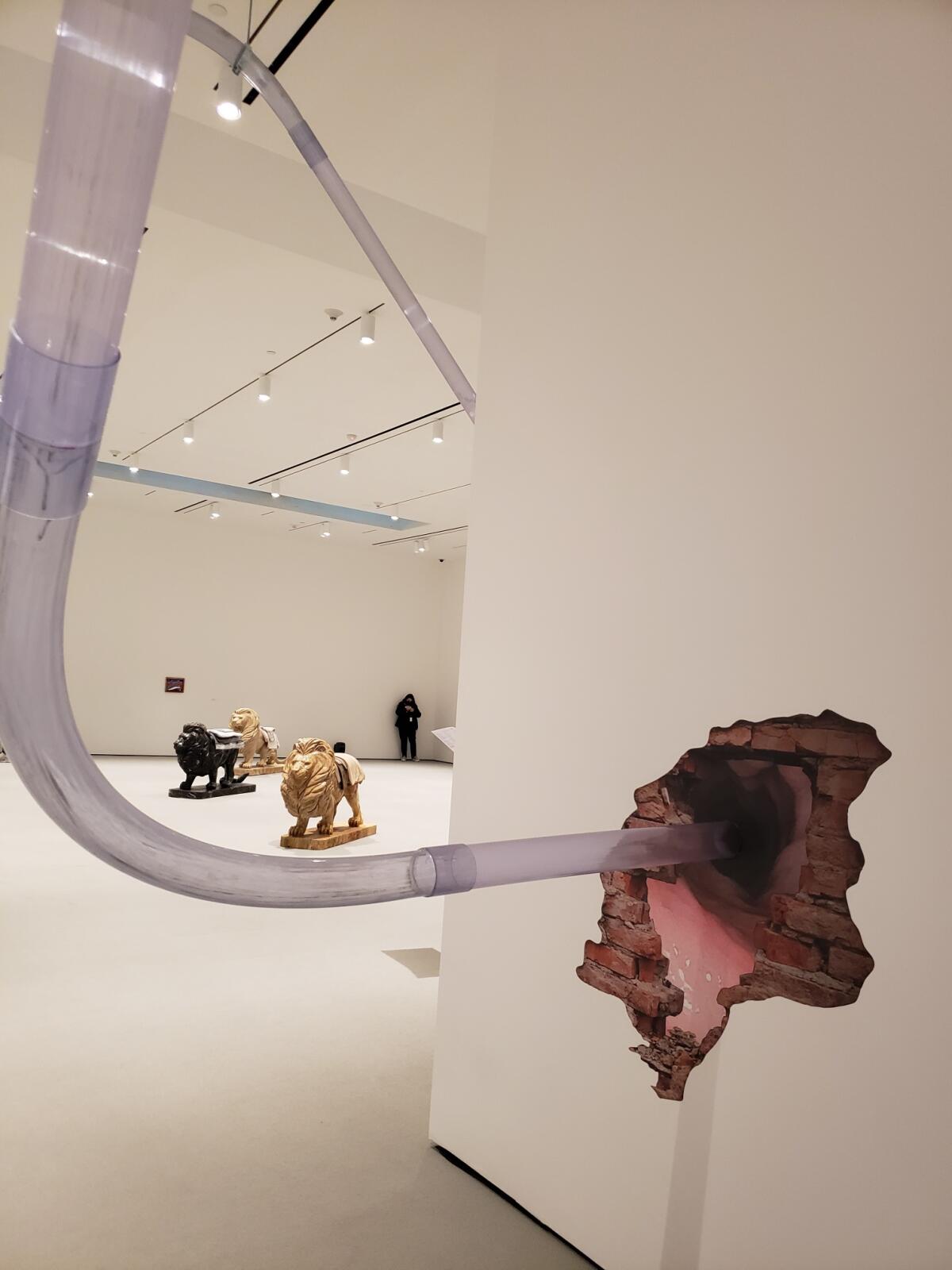
Air Tube Transfer Systems, the Orange-based company that built the one in the Hammer show for Scottish-born, London-based artist Morag Kiel, has lots of suggestions on its website for contemporary applications. “A 300-foot run travels in under nine seconds,” it boasts. “A 500-foot run is less than 14 seconds. Try that on foot.”
Judging from the show, I believe them. The capsule rockets by. Art is not one of the proposed uses, but here it is.
The wall label reveals that what’s periodically whooshing over and around your head, unseen in capsules hurtling along inside this pneumatic tube, is artificial vomit. I believe that too. Like the digital decals of a smashed wall, inner fakery is fundamental.
And I suppose regurgitation could be a credible theme, although it feels rather old-fashioned now. Beginning in the 1980s, L.A. artist Mike Kelley began developing a robust, often funny body of work based on metaphors of a human body’s alimentary canal — the path from the esophagus through the intestines where food goes in one end, nutrients get extracted and waste comes out the other end. The exhibition’s pneumatic tube busting through digital walls is its own such raucous canal, although here it backs up and barfs with a decidedly cynical edge.
The synthetic heave is a wan sight gag, a self-reflexive expression of one’s own artificiality. It feels especially flat in the vicinity of the retrospective of artist Ulysses Jenkins, also currently on view at the Hammer, which sets off sparks.
‘Without Your Interpretation’ is the first major retrospective of the L.A.-born Jenkins, whose prescient videos touch on race and other the issues of our age.
Jenkins — an early adopter of video as a tool for artists, back when the technology was brand new around five decades ago — pressed his homemade electronic media against oppressive corporate standards set by commercial television. Video works like “Mass of Images” (1978) and “Inconsequential Doggereal” (1981) use the artist’s individual Black body as a conduit through which the social and cultural stereotypes relied upon by mass media flow. In Jenkins’ hands, they are dissected and revealed as wicked absurdities.
“Lifes” features a compelling pair of odd park benches by Cooper Jacoby, visually wrapped in an illusionistic, lizard-like palette of peeling green-and-rust metallic lacquer. The surface of each bench is in fact a sensor of the body heat generated by anyone who sits down. It’s hooked up to a sort of digital thermostat that transfers the temperature reading into scripted prose-poetry produced by an Artificial Intelligence program.
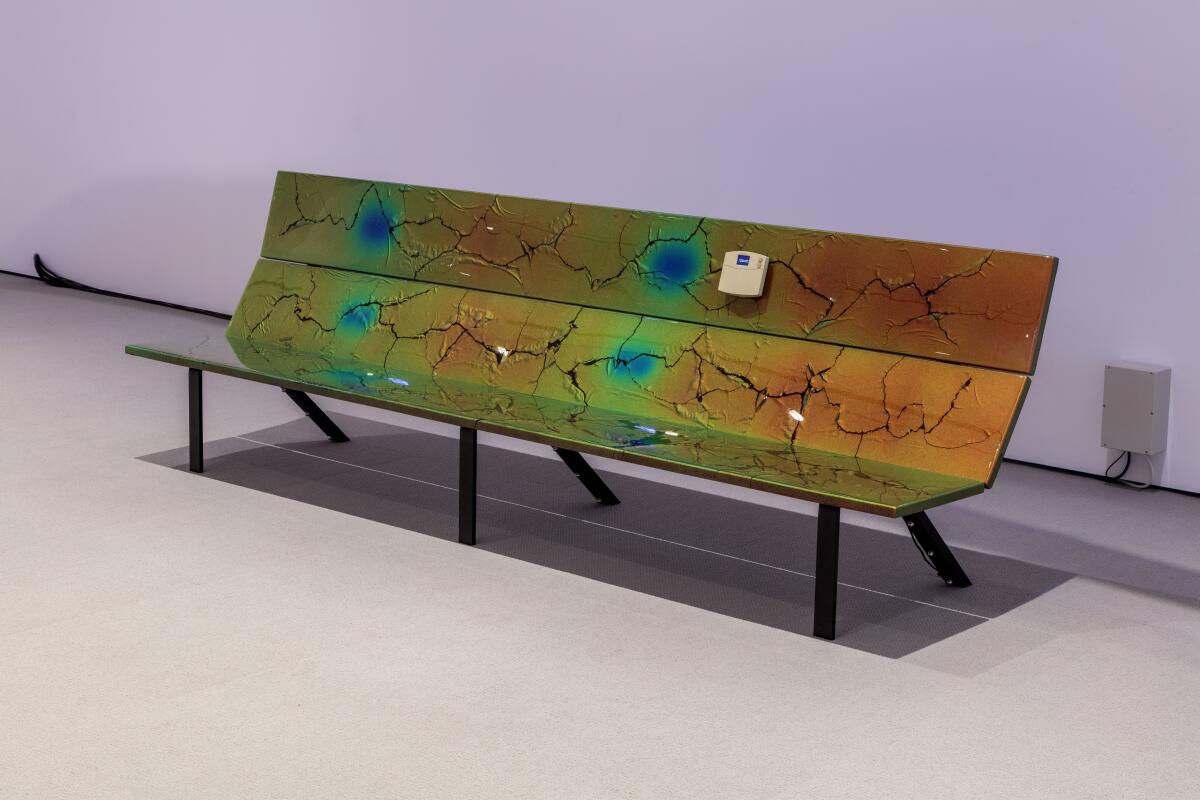
When another person sits down beside you on the bench and the temperature changes, whatever literary marvels (or, remembering Jenkins, inconsequential doggerel) your own body might issue forth in combination with advanced technology gets disrupted — and maybe enhanced, maybe ruined. Collaboration is always iffy.
Collaboration is what Hammer curators Aram Moshayedi and Nicholas Barlow had in mind for “Lifes,” hence the awkward multiplicity in the title. Their abstruse process for organizing the show began with four written texts. Authors Fahim Amir, Asher Hartman, Rindon Johnson and Adania Shibli then engaged other artists to become involved, until there were about 50.
Who did what is not always clear — which is presumably part of the point — while a considerable portion of the exhibition consists of projected video as well as audio and spoken-word pieces emanating from speakers that ring the wide-open gallery, just where the wall meets the floor. The echoing sound is not always comprehensible.
In essence, “Lifes” is a sizable show of brand-new commissions — a risk that, while certainly commendable for a usually cautious institutional space like a museum, doesn’t pan out here. Less exhibition than academic exercise, with barely a dozen objects (including video) in the room, the show feels thin. The bulk of it is literary and musical, not visual, in time-based forms confined to an hour-long program schedule — which means you must hang around to engage with them, fingers crossed.
A few preexisting works got folded into the mix as the collaborative curatorial process evolved. In addition to Jacoby’s, among them are the show’s most rewarding works.
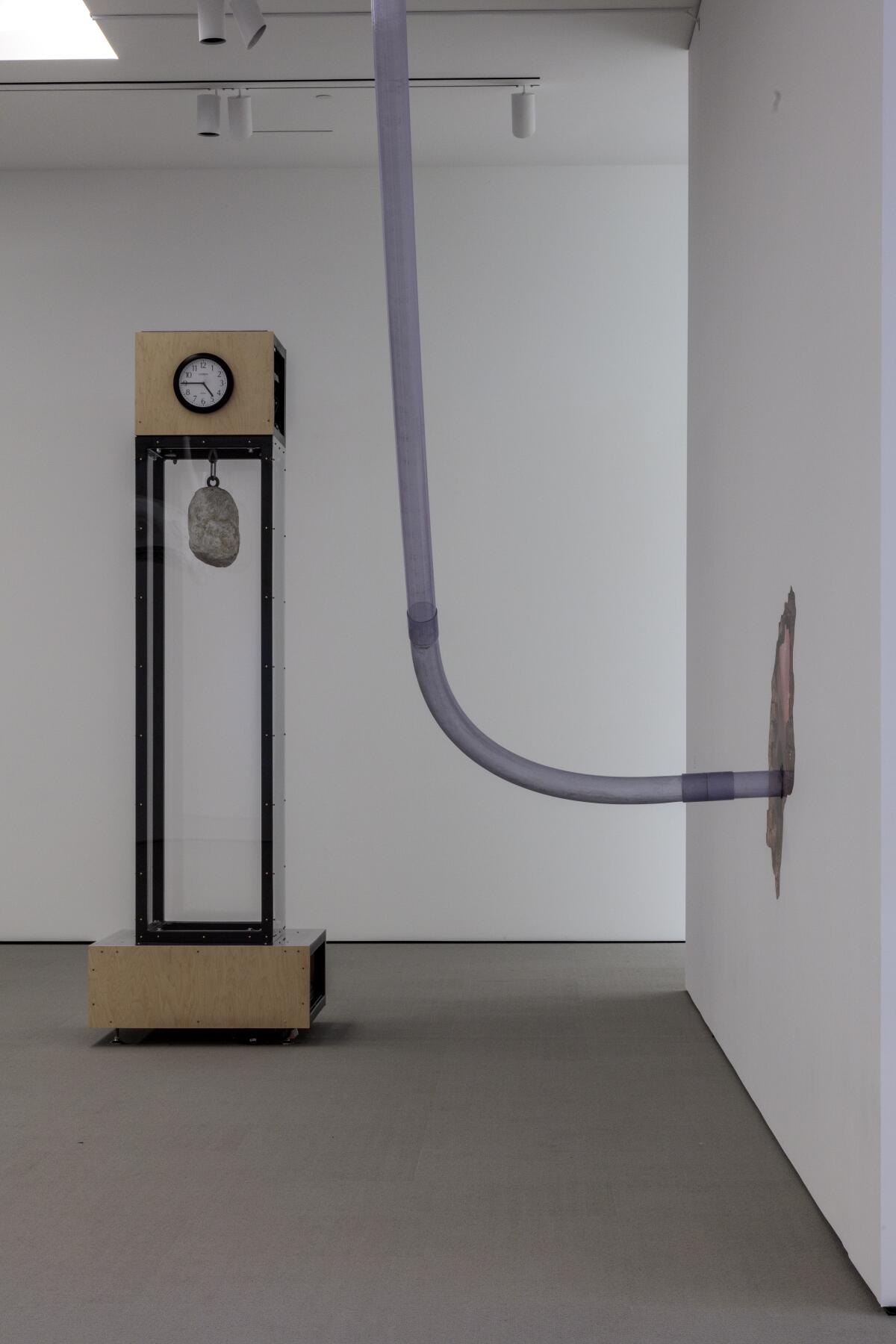
Charles Gaines’ “Falling Rock” (2000) is a hefty chunk of granite hauled up by a chain on a motorized winch inside a glass booth until, at the top, just beneath a ticking clock, a release mechanism sends it plummeting to the ground. The stone smashes noisily through a fragile sheet of glass. An industrial-strength Sisyphus machine, the relentless contraption is grimly disturbing.
“Parade” (1993) is a marvelously strange video by German artist Rosemarie Trockel, known for cross-pollinations between weaving and painting. In the video, glowing white silkworms laid against a deep-blue background seem to perform careful choreography to music by Kurt Hoffman. Patterning associated with textiles merges with kaleidoscopic dance routines of a larva-world Busby Berkeley.
Finally, a small, startling, 2016 painting by L. Frank, a Tongva-Ajachmem artist (also known as L. Frank Manriquez), imagines a world-shattering moment in a simple acrylic palette dominated by red, white and blue. A Spanish galleon, fronted by a carved blond figurehead leaning out toward land, almost like a battering ram, butts up against the shore of what would eventually be called California.
Eternal stars shining overhead, a big and little dipper, are quietly heartbreaking witnesses to Earthly affairs. A row of little white crosses separating water from land is like a permeable fence, its shapes doubling as funerary markers. The heartfelt modesty of the image is infused with deeply personal insight, resonating with the historic wallop of the event.
'Lifes'
Where: UCLA Hammer Museum, 10899 Wilshire Blvd., Westwood, (310) 443-7000
When: Through May 8. Closed Monday.
Contact: www.hammer.ucla.edu
More to Read
The biggest entertainment stories
Get our big stories about Hollywood, film, television, music, arts, culture and more right in your inbox as soon as they publish.
You may occasionally receive promotional content from the Los Angeles Times.
